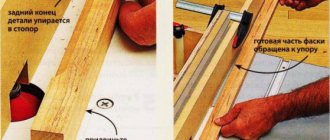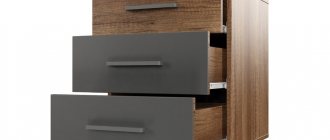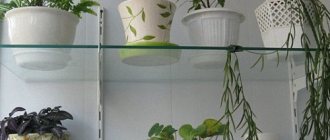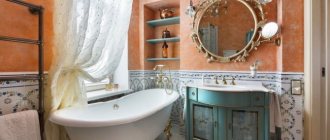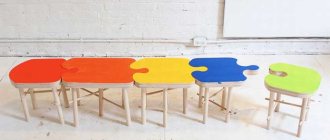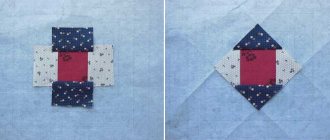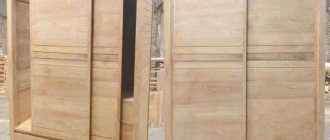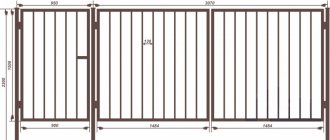There is nothing better than shelves for organizing space in rooms, as well as for decorating the interior. Comfortable, functional, original in shape, they help to conveniently arrange a lot of things and give the rooms a more comfortable look. Making shelves on the wall with your own hands is not at all difficult, and you can use a wide variety of materials - wood, fiberboard, glass, pieces of tin, plywood.
DIY wall shelves
DIY wall shelves
Original shelf from an old TV
| Types of Wall Shelves | Description |
| Classic | This type of shelves is the most common due to its simplicity, aesthetic appearance and ease of installation. They represent a huge flight of fancy: from simple square to creative asymmetrical shapes |
| Corner | This type of wall shelves differs in the method of fastening - it is carried out on adjacent adjacent walls. Most often they are installed in utility rooms and bathrooms. |
| Hanging | This original way of creating a shelf involves attaching a simple structure to the ceiling using cables or vertical posts. |
| Floor-standing | This wall shelf is a floor support design. This type of product is especially relevant in hallways, as well as large rooms, where you don’t have to think about wasting space. |
| Open and closed shelves on the wall | Wall shelves can be designed, for example, with or without glass |
Making a simple wooden shelf
DIY wall mounted bookshelf
Wood is the most convenient material to work with. Wooden shelves come in simple, complex shapes, open and closed, vertical, horizontal and corner. Taking the basic option as a basis, you can assemble a shelf from several modules and give it the most incredible look. In order for the product to serve for a long time, you should choose the right wood: the boards must be perfectly flat, completely dry, without cracks, voids or traces of mold.
Wood for shelves
During the assembly process you will need:
- hacksaw;
- drill;
- building level;
- pencil and ruler;
- boards 16 mm thick;
- stain;
- wood varnish;
- sander;
- screws, brackets, dowels.
The example used is a simple rectangular shelf 250mm wide, 300mm high and 1100mm long.
Wall shelf diagram
Step 1. Marking
The boards are laid flat on the table and the measurements are transferred from the drawing. The height of the side walls should be 268 mm, since they will be located between the top and bottom: wall height + board thickness x 2 = 300 mm.
Step 2. Cutting the boards
Cutting the boards
If the markings exactly match the diagram, you can start cutting. It is best to use a jigsaw for this, then the cuts will be perfectly smooth and neat. You should end up with 2 long pieces and 2 short ones.
Step 3. Processing of blanks
Sanding the board
Before starting assembly, each workpiece must be sanded, stained and varnished. If you plan to simply paint the shelf, the blanks are treated with an antiseptic primer - this increases their service life and makes the paint apply more smoothly.
Step 4. Assembling the product
Assembling the shelf
The bottom board is laid flat on a flat surface. From the ends of the workpiece, retreat 8 mm and draw 2 straight lines parallel to the cuts. Now on these lines you need to mark two points at a distance of 5 cm from the edge, and drill holes there for the screws. The same is done with the top blank. When all the holes are ready, install the side blanks on the bottom board and tighten the screws. Place a second board on top and also fix the side walls with self-tapping screws.
Assembling the shelf
Brackets are attached to the ends of the side walls, holes are drilled in the wall for dowels, self-tapping screws are inserted and tightened so that they protrude by about 5 mm. The dowels must be positioned strictly horizontally, so before drilling, mark a line using a level. Now all that remains is to attach the brackets to the fasteners and hang the shelf. If desired, the back wall of the product can be filled with a piece of plywood, and glass can be inserted in front.
Shelf
Bookshelf
To make such a simple shelf more original, you can replace one side wall with a stump of a thick branch. To do this, choose an even branch with a diameter of about 7-8 cm with smooth, clean bark, saw off a piece 28 cm long, and cut off all the side shoots. The chock is treated with a primer, dried and varnished. There is no need to remove the bark. After the varnish has dried, the workpiece is inserted between the upper and lower boards and screwed tightly with self-tapping screws.
To make such a simple shelf more original, you can replace one side wall with a stump of a thick branch
Based on this drawing, you can make various variations of wall shelves. For example, reduce the length to 400 mm and make 3-4 blocks at once. Then install them on top of each other in a checkerboard pattern and secure them together using metal plates. Or simply mount them on the wall separately, placing them at a short distance from each other.
How to hang shelves
How to make a bookshelf with your own hands
Before you start making a shelf, you need to see what material is available. After this, they begin to develop the project and look for an idea. They immediately decide on the location, since the size and shape of the future structure will depend on this. When all the nuances are clarified, they begin to bring the idea to life.
DIY book shelf made of wood
To assemble the shelf you will need an edged polished board 15-20 mm thick. It is better not to use pine and other coniferous wood. Over time, such boards will begin to release glue. In addition to the obscene appearance of the shelf itself, the book collection will be damaged.
The classic scheme is based on the assembly of a regular rectangular shelf
It is easier to assemble a classic rectangular structure from wood. The process consists of the following steps:
- To assemble the body, 4 blanks are first sawed off. You should get paired elements. In the diagram they are indicated by the letters “A”, “B”. A rectangle is assembled from the boards. Self-tapping screws are used for connections, but it is better to take furniture screws - confirmed ones. With such fasteners the finished product looks better. A hole is drilled for each screw, otherwise the workpiece will crack.
- When the case is assembled, it needs to be given an exact rectangular shape and fixed so that distortion does not occur during operation. There are 2 options here. If the back side is closed, then it is sewn up with a sheet of fiberboard. In the diagram, the element is designated by the letter “C”. When it is intended to create an open bookshelf, the back side is not sewn up. To prevent the body from warping, metal flat corners are attached to each corner at the end of adjacent boards with self-tapping screws. These elements are used on wooden window frames.
- When the case is ready, the locations of the shelves are marked on the inside of the side posts. In the diagram they are indicated by the letters “D”, “H”. The distance between them, as well as their number, is determined individually. It is not necessary to use a diagram here.
- The shelves can be made removable or fixed. In the first option, blind holes are drilled from the inside on the side posts, chips are inserted, and a board is laid on them. In the second option, through holes are drilled. The shelf is fixed to the side posts with self-tapping screws or furniture screws.
The wooden structure is subjected to final sanding. The wood is decorated with varnish, stain, and acrylic paints.
DIY plywood bookshelf
The advantage of plywood is that the sheets are wide compared to the board. There is room for your imagination to run wild here. However, plywood tends to delaminate. Each node will have to be reinforced with overhead metal corners and plates.
For a plywood bookshelf, small cell sizes are acceptable, since the material tends to sag and delaminate under load
You can use plywood to build a book shelf for your children's room with your own hands. To do this, you will first need to draw a pattern on paper. Each element is cut out and transferred to a plywood sheet. After marking, the fragments are cut out with a jigsaw. The ends are carefully polished, since after sawing there will be a lot of burrs.
The easiest way is to cut out the elements for a plywood bookshelf with a classic rectangular shape.
The cut elements are connected using the provided grooves using the designer’s method. On the back side, the nodes at the connection points are reinforced with metal corners or plates. If a back wall is provided, then simply nail a piece of fiberboard with small nails. The plywood is decorated with paints and varnishes or covered with colored self-adhesive film.
Homemade glass book shelf
For glass shelves, it is optimal to use material with a thickness of 5 mm or more. Cutting thick glass is difficult and requires experience. First, markings are applied to the sheet with a marker. The glass is laid on a perfectly flat surface. The glass cutter is pressed firmly against the sheet and one line is drawn. It is not advisable to repeat the action. If you get a few scratches, the edge will crumble or a crack will spread across the entire glass.
Glass cutting begins with markings
The glass is moved so that the scratch cut by the glass cutter is on the edge of the table. From under the bottom, the sheet is first tapped with the handle of a glass cutter. A crack should follow the scratch. When it spreads over its entire length, they try to break the glass with a sharp pressure of the hand. If it fails, the tapping procedure is repeated.
When the element is cut, the edge of the glass is rounded with a grinder. Further actions are aimed at creating fasteners. Special brackets are purchased in the store. They are attached to the wall with dowels. The glass sheet is fixed directly onto the brackets themselves.
Special brackets are used to fix the glass bookshelf.
DIY book shelf made of cardboard
Craftsmen create voluminous shelves of complex shapes from thick sheets of cardboard. To make them, patterns are used, which are often made independently. To go the simple route, you will need several cardboard boxes. They are used to assemble a bookcase in a couple of hours.
Important! The boxes are selected according to size so that a book can fit inside freely.
The boxes are connected to each other with metal clamps
The process of assembling a bookcase is simple. The boxes have opening shelves that act as lids that are cut off. They are installed on top of each other in a pyramid. Each box is a separate cell of the bookcase. The boxes are fastened together with metal clamps. The finished bookcase is painted with acrylic paint. For decoration, you can cover it with fabric, self-adhesive film, or wallpaper. The structure is installed on the floor. You cannot hang it, otherwise such a shelf will break under the weight of books.
DIY book shelf made of chipboard
The technology for assembling a bookshelf is exactly the same as in the version with a board. The difference is the material. It is advisable to use chipboard with a laminated surface. Fragments can be cut from an old disassembled cabinet.
The best material is laminated particle board
After sawing the chipboard, an unsightly edge remains that needs to be decorated. First, the end of the slab is ground. The next step is gluing a special edge tape. To do this, heat the iron by setting the temperature regulator to the middle position. First, they try to glue a piece of edge onto an unnecessary piece of chipboard. The tape is laid on the workpiece, covered with a cotton cloth, and ironed. If the edge has not melted and stuck securely, the temperature has been chosen correctly.
The tape is glued to all front ends of the bookshelf. The protruding edges on both sides are carefully trimmed with a sharp knife. If a visible white streak remains, it can be rubbed off with fine-grained sandpaper. After pasting all the blanks, the shelf is assembled according to the drawing.
DIY invisible book shelf
The invisible book shelf option is an interesting decorative element. Visually, it seems that the books near the wall are hanging in the air. To work from materials you only need a metal corner and dowels.
Important! One of the sides of the metal corner should be long so that it can hold books.
The corners are fixed at the same level
There are two design options. In the first case, two corners are attached with dowels to the wall at the same level. The distance between them is a couple of centimeters less than the width of the books. The long sides of the corners protrude forward. Books are placed on them. The downside of the design is the fact that the shelf is not completely invisible. The protruding planes of the corners are visible from below.
The corner becomes invisible if it is embedded inside a book
The second option allows you to create a completely invisible shelf, but this will require an unnecessary book. The protruding plate of the corner is hidden under the binding. To prevent the book from sliding out, self-tapping screws are driven directly into it over its entire thickness. A stack of desired books is placed on a fixed book stand.
DIY creative bookshelf
You can create a creative hanging shelf in a children's room or on the veranda, but hang it not in the usual way, but with ropes. To make it you will need two boards. You can use chipboard and plywood. Cut out two identical rectangles. The parts are stacked on top of each other, and holes are drilled in the corners.
To ensure that the holes on the two workpieces coincide, the parts are stacked before drilling and clamped with a clamp
The rope is threaded into each hole of the workpiece, and restrictive knots are tied. They will hold the shelves at a certain height. The free ends of the rope are connected into one rope and tied into a large knot. This part is used to hang the shelf on a bracket fixed to the ceiling.
To hang a creative shelf, a bracket is screwed into the ceiling
DIY bookshelf from scrap materials
A beautiful shelf will be made from the laminate sheets left after the renovation. However, due to the weak strength of the material, the design is made for floor or tabletop installation. You cannot drill into the laminate, as it will crumble. The same goes for self-tapping screws. There is only one way out - glue with a hot gun.
Laminate elements are glued with a hot gun
Use a jigsaw to cut the pieces to the required length. Since the laminate is thin, so that the shelves do not sag, spacers are installed in the form of vertical partitions. On the back side, it is also advisable to secure at least one sheet vertically for rigidity. In addition, it will prevent the structure from warping, otherwise it could collapse like a house of cards.
Corner wooden shelves
Often, to save space, shelves are made corner, and they can be mounted both in the inner and outer corners.
Corner shelf Corner wooden shelves
The blanks are made according to the scheme described above, only the upper and lower boards consist of two elements, with the ends cut at an angle. The process of making such a shelf is quite simple:
- the halves of the top board are coated at the ends with glue and clamped with clamps;
- repeat the same actions with the bottom board;
- when the glue dries, all workpieces are covered with stain or primed;
- Attachment lines are marked on the upper and lower workpieces and holes are drilled;
- insert the side walls and secure them with self-tapping screws.
Next, screw the brackets and secure the shelf to adjacent walls.
Corner shelf made of wood
| Wall shelf materials | Advantages and disadvantages |
| Wood: plywood, chipboard, MDF and others | This material is relatively easy to work with, it looks beautiful, natural and impressive, its service life is quite long, especially if pre-processed |
| Plastic | This material is the most versatile; it can imitate both wood and stone, while eliminating their shortcomings |
| Metal | Such wall shelves will be very strong, reliable and durable, but they will hardly fit into a classic interior. In addition, corrosion can also be a problem, so metal products will require special processing and conditions |
| Glass | Transparent wall shelves will create an atmosphere of lightness and comfort in your home. Of course, it will be quite difficult to make a glass structure with your own hands, but if you nevertheless decide to do all the work yourself, then you will have to work with glass for quite a long time and very carefully, especially if various cutouts are planned in the shelf design |
Types of corner shelves
In order to decide on the type of product, it is worth studying the features and characteristics of various models that are used in certain rooms.
To rationally plan the interior, it is worth using the corners and, thus, freeing up the walls for cabinets and shelving.
For kitchen
For greater convenience, it is necessary to have all the necessary items at hand. A convenient and spacious shelf will help you cope with this.
It is almost impossible to imagine a home, office or apartment without convenient shelves.
For the kitchen, natural wood or materials containing it are best suited. Avoid using plastic, glass and metal due to their susceptibility to moisture. In terms of shape, it is better to give preference to the usual rectangular design with sides in the form of figures.
Corner shelves will help you make the most of room space and eliminate “dead zones” in the room.
In the kitchen, a shelf is used to store spices, cutlery or figurines. Therefore, it is not necessary to strengthen it much, since it is not intended for heavy objects.
For the living room
This room is intended for relaxing and receiving guests, so the shelves are mainly used for decoration. Here you can place family photos, figurines and decorative items.
In order to choose the right model, it is important to base it on the load that is placed on the product. So, to store books from your personal library you will need a durable and fairly spacious shelf.
Shelves help free up space and diversify the usual interior of the room.
In this case, you can use any material: wood, glass, metal or plastic. The choice depends on the purpose of the product. When using a glass structure, do not clutter the shelf, otherwise it will look too busy and not elegant, as planned.
Shelves can be made from different materials, and here you need to take into account the interior of a particular room.
Shelves made of plasterboard or wood will look great. Such products look sophisticated and are interior decorations in themselves.
For bathroom
In this room you cannot do without a comfortable and spacious shelf. When choosing, keep in mind that the bathroom has high humidity and the material must be resistant to water; wooden and metal structures should be avoided.
Glass is resistant to high temperatures, moisture and heavy loads.
The shelf should be spacious and roomy so that all the jars and tubes can be placed. And also durable and reliable, since it must withstand heavy loads.
With the help of an elegant glass shelf you can make the interior light and weightless.
For the bathroom it is best to choose:
- Glass with chrome plated stands;
- Plastic with metal stands.
Note! The simpler the design, the easier it is to wipe. In conditions of high humidity this is a very important condition.
Original shelves for books
Shelves of non-standard shape are in increasing demand, so if you wish, you can try to assemble something original. For example, a bookshelf in the form of a simplified labyrinth is used.
To make it you will need:
- edged board 20 mm thick;
- wood glue;
- clamps;
- roulette;
- level;
- hacksaw;
- miter box;
- Sander;
- stain;
- furniture screws, self-tapping screws;
- decorative shelf holders.
If you have everything you need, you can start making the shelf.
Step 1. Marking
On the prepared boards, mark the cut lines with a pencil under a ruler. Measurements should be taken very carefully, since all horizontal parts have different lengths.
Step 2. Trimming the blanks
The ends of each workpiece are cut at an angle of 45 or 90 degrees. The diagram shows the first option, so you will need a miter box for sawing. It is very important to correctly install the miter box on the board so that the cuts are symmetrical. If the ends are cut off incorrectly, you will not be able to fold the shelf.
Step 3. Assembling the structure
The ends of the parts are smeared with glue, pressed tightly and additionally secured with slotted furniture screws. Ordinary self-tapping screws are not suitable here. Each joint will require at least 2 screws. Both parts of the shelf are applied to the wall, leveled and the attachment points are marked with a pencil. After this, holes are drilled for the dowels, brackets are screwed to the shelf with self-tapping screws and the structure is hung on the wall. Instead of brackets, decorative pelican shelf holders are often used.
Shelves of non-standard shape
Wall shelf size chart
Shelf
Hanging shelf with straps
If you need a decorative shelf for small items, the following option is perfect - a board suspended on straps.
Hanging shelf with straps
Hanging shelf
To make a shelf you will need:
- 2 edged boards 300x750 mm, 30 mm thick;
- 4 leather belts, 75 cm long;
- 4 long screws with plastic dowels;
- 4 short screws;
- building level;
- ruler;
- sharp knife;
- drill.
Step 1: Preparing the belts
The cuts of the belts must be perfectly even, so if necessary they are trimmed with a knife. Fold each belt in half, press the ends to the table, step back 2 cm from the edge and drill a neat through hole with a drill. The same is done with the remaining three.
Step 2. Attaching the straps to the wall
Using a level, two points are determined on the wall at a distance of 60 cm. Holes are drilled and plastic dowels are inserted. The belt folded in half is applied to one of the holes and secured with a long screw - you get a large loop on the wall. Another such loop is attached nearby.
Step 3. Installing the shelf
A sanded board is inserted into the loops and aligned horizontally. To prevent the shelf from moving, the parts of the belts adjacent to the wall near the board itself are screwed with short self-tapping screws. Now another shelf is hung under this shelf, exactly repeating the steps described above. The result is a light and neat two-tier shelf. If desired, you can add another 1-2 tiers.
To make the shelves described above, you can use not only wood, but also plywood, as well as laminated chipboard sheets. The last option is used most often, since laminated chipboard is lightweight, high strength, practicality and durability. When assembling shelves from this material, all sections must be covered with a melamine edge to match the color of the sheet.
Shelf with straps, hanging Shelf with straps
Hanging shelf with straps
Making a glass shelf
Glass shelf
Glass shelves fit harmoniously into any interior, and the installation process does not take much time. To work you will need:
- strained glass;
- hammer;
- electric drill;
- building level;
- aluminum profile;
- dowels;
- adhesive tape;
- ruler;
- pencil.
Not everyone knows how to cut glass correctly, and therefore it is better to order the cutting of blanks in a workshop. There they will also grind and polish the edges so that when installing the shelf you will not cut yourself on sharp edges. You can do everything else yourself.
Glass shelf
Step 1. Marking for fasteners
Marking
The section of the wall where the shelf will hang should be as level as possible. Using a building level, draw a horizontal line on the wall with a pencil. The locations of the fasteners are marked on the line and holes are drilled.
Drilling holes
Step 2. Installing profiles
Holders for glass shelves
Profile for glass shelves
An aluminum profile is applied to the wall surface and the alignment of the fastening marks is checked. Then insert dowels into the holes, attach the profile with one screw and level it horizontally. After this, tighten the remaining screws.
Insert the dowel
Insert the dowel
Instead of a drill, insert a bracket screw
Screw in the bracket screw
Leave the bracket screw protruding from the wall
We put the washer on. We screw the bracket onto the screw.
Checking the position
Arranging the shelves
Step 3. Attaching the shelf
The rear edge of the glass shelf is covered with adhesive tape. You can use separate spacers made of tape, placing them where the glass will touch the screw heads. The shelf is inserted into the profile, the edges of the profile are covered with protective caps. If two shelves touch on the sides, their edges are fastened with metal fittings.
Shelf materials
Before starting work, you should decide on the material in accordance with the conditions and interior of the room. Corner shelves are made from the following materials:
- Solid wood or boards. Scraps remaining after repairs will do.
- Chipboard and MDF boards. Pieces of suitable size can be purchased inexpensively on the market.
- Multilayer plywood.
- Glass with a thickness of at least 5 mm.
- Plastic.
- Window sill profile.
- Metal.
The first 3 options are the most popular, so every home craftsman will have the necessary tool to work with them.
However, there will be no difficulties with others if special operations (for example, shaped cutting of glass) are ordered in a workshop.
Unusual shelves made from scrap materials
If you have free time and a desire to experiment, you can create very unusual shelves for the wall from scrap materials. For example, a corner shelf made of plastic pipes looks original. To make it you will need sections of sewer pipes and corner bends. The shelf is attached to the wall with screws and dowels.
Unusual shelves made from scrap materials
Unusual shelves made from scrap materials
Old suitcases and briefcases also make great wall shelves. To do this, they are cut to half their height, covered with plywood at the back and secured to the wall with screws or on brackets.
Shelves made from old suitcases
Drawers from unnecessary bedside tables are quite suitable for making shelves. To give them an elegant look, the boxes should be carefully sanded, primed and painted in bright colors. Then they are leaned against the surface with the back wall, the attachment points are marked and holes are drilled for them. Even one such shelf looks very original, and a composition of 2-3 drawers will become a real decoration.
Bright shelf
Bright shelves
Video - DIY wall shelves
DIY photo of shelves
Read here - Wine rack - 115 photos of the best ideas on how to make a beautiful and stylish wine rack with your own hands
Did you like the article?
0
Interesting wooden shelf. Master Class
Original DIY bookshelf
You will need:
- Rope;
- Board at least 2 cm thick;
- 2 corners (mounts) for shelves;
- Steel washers;
- Lighter;
- Drill;
- Saw.
Using a saw, we cut the board into several parts so that we get 2 bars of 6 cm and 11 bars of 5 cm
Now, using a drill, we drill holes in the existing bars. Pull the cord through all the bars, using washers in the form of separators (3 pieces each)
We stretch the cord through all the bars, using washers in the form of separators (3 pieces each)
We fix the corners We hang the shelf
Material selection
You can make an interior item from different, and sometimes unexpected, materials. But in most rooms such designer products are not needed. Therefore, shelves are most often built from easy-to-process sheet materials (plywood, MDF, gypsum board), the scraps of which remain after repairs.
Features of working with chipboard
Sheet material consisting of compressed and glued wood chips is easy to process and is used for furniture products along with wood. After sawing, a simple chipboard part can be painted or covered with a film of the desired color. A corner shelf, assembled with your own hands from chipboard, will immediately acquire an aesthetic appearance.
It is important to know: working with laminated chipboard or MDF brands requires care when cutting the sheet. The decorative layer easily chips along the cut line, and the finished product looks sloppy.
To preserve the coating, it is recommended to stick masking tape along the cut line, and use a jigsaw and a fine-toothed blade for cutting.
Wooden shelf
The small width of wooden planks prevents you from fully realizing your design when using them as material for shelves. But narrow, straight, open-type products made from smooth parts are better than from sheet material. Solid wood is more durable than chipboard and is better resistant to moisture. A beautiful cut pattern is decorative without additional processing and often only requires the application of varnish.
Plywood is a lightweight and reliable material
A type of sheet material consists of several layers of wood veneer glued together. The strength and moisture resistance of plywood is higher than that of chipboard, and it is just as easy to process. When cutting plywood parts, special attention must be paid to processing the edge after cutting. To ensure that the edge is smooth and without burrs, the edges are polished with emery cloth.
To make a corner shelf with your own hands not only durable, but also beautiful, the plywood can be painted, varnished or covered with film. Decorative coating is required only for brands that do not have a factory treatment. The different thicknesses of plywood allow it to be used for shelves bearing high loads.
From plasterboard
Cutting gypsum boards is done with a jigsaw or a hand saw and does not cause any difficulties. But the material itself is quite fragile and is rarely used for products under high loads. Strength can be added using additional profiles from which the frame of the rack is built, but even in this case its load capacity is limited.
To build a shelf with your own hands, use the same installation method as for any gypsum plasterboard products. First you need to make a frame from metal profiles. After this, the shelf parts are attached to the frame. Finally, the joints with the wall are puttied and the new shelving is painted.
